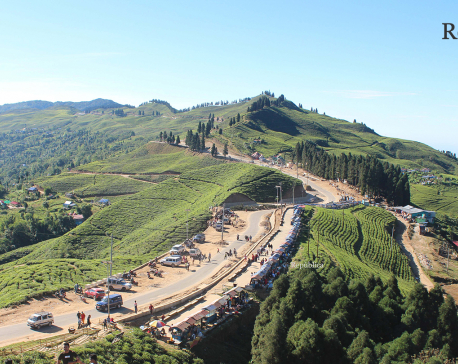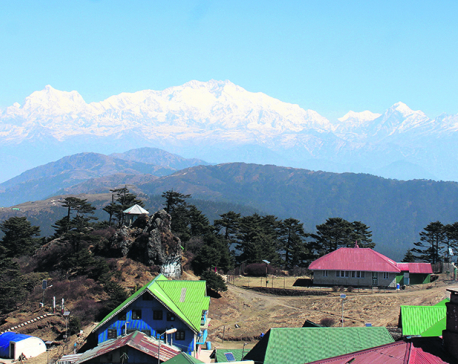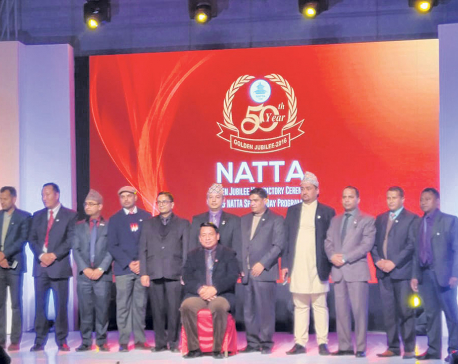
OR
Wonderful Ilam where culture and nature compliment each other
Published On: April 17, 2021 06:31 PM NPT By: Vidhu Prakash Kayastha

Ilam is home to various ethnic groups like Limbu, Rai, Lepcha, Gurung, Magar, Newa, Khas, Arya etc. Cultural variety can be seen in Ilam in festivities with mind blowing music and colorful costumes.
Located in the north-east hills of Nepal, the hill town of Ilam bears historical importance. Ilam was the headquarters of one of the 10 principalities of Limbuwan. The Limbuwan-Gorkha War was a progression of battles between the King of Gorkha and the chieftains of different realms of Limbuwan from 1771 to 1774.
The conflict reached a conclusion in 1774 with a truce settlement known as the "deal of Salt and Water” based on the principle of coexistence between Yakthung Lake Limbuwan kings and the Gorkha ruler. It perceived the concurrence of government situation and equivalent rights between the Gorkha King and Yakthung Lake Limbuwan Kings. Ilam was the last among the 10 principalities of Limbuwan to be included in unified Nepal.
The administrative status of the medieval settlement of Ilam was elevated as Gauda, meaning administrative centre, in the year 1818. The bi-centenary (1818-2018) of the Ilam bazar was observed with much fanfare in the year 2018.
With the Ilam bazar as its core area, Ilam Municipality is spread over human settlements of Godak, Soyak, Barbote, Maipokhari, Sumbek, Puwamajhuwa, Sangrumba, Siddhithumka and Sakhejung. The settlements represent a rare combination of ethnic and bio-diversity and tea estates having panoramic views. The tea estate in the Ilam bazar is one of the oldest tea estates of South Asia that came into operation after Col Gajraj Thapa planted the tea saplings that were received as a gift from the Government of China in the year 1873.
Col Gajraj Singh Thapa, who was the Governor-General of Eastern Nepal, initiated the implementation of two plantations: Ilam and Soktim Tea Estates of 52 hectares each and thus sowed the seeds of the Nepali tea industry. The first Nepali tea produced was an Orthodox tea of the hills. The Ilam orthodox tea with aromatic flavor is one of the best teas in the world. The roasting of tea leaves in machines began in Nepal after the establishment of a tea factory in 1878 in Ilam. However, the local tradition of making handmade artisan organic long green tea is still in practice. The tea estate adjoining the human settlement with commercial markets on the ridges and slopes are the most interesting and value-adding factors in the different wards of Ilam Municipality. Anyone who loves to travel in the hills will certainly be thrilled to taste the aroma of orthodox tea amidst the panorama of Ilam.
Ilam is home to various ethnic groups like Limbu, Rai, Lepcha, Gurung, Magar, Newa, Khas, Arya etc. Cultural variety can be seen in Ilam in festivities with mind blowing music and colorful costumes. Lepchas and Limbus, the native people of Ilam, have unique personalities in their cultural lives. Various celebrations of the clans that fall in different seasons are observed eagerly and enthusiastically. The extraordinary enthusiasm of the indigenous people is noticeable in their traditional style of singing and dancing.
Culturally rich Ilam has numerous feathers of bio-variety in its hat. Mai Pokhari is a wetland in Ilam that was listed in the Ramsar sites on 28 October 2008. The lake inside the wetland which reflects emerald waters has a boundary of around 1 kilometer (0.62 mi). On the fringe of the lake there is the Maipokhari Botanical Garden of agricultural and natural significance which houses a stone nursery, an orchid house, plants gathered from numerous locales of eastern Nepal, and a greenhouse.
The wetland is in the center slope scopes of the Himalayas at a height of around 2,100 m (6,900 ft) and covers a space of 90 hectares. It is around 15 km toward the north of Ilam. The wetland has been created to preserve the ground subsidence. The wellspring of water in the wetland is from common springs and precipitation, which is the principal source of water supply for neighborhood people.
Experts have identified varieties of specimens in the flora and fauna of the wetland. The wetland's flora consists of Schima, Castanopsis, laurel oak (Quercus laurifolia) and epiphytic orchids. Water lily, cone trees, rhododendrons, and herbal plants are noticeable in the area.
Faunal species incorporate white-rumped vulture, panther feline (Prionailurus bengalensis), Eurasian otter (Lutra), and endemic Variegated mountain reptile (Japaluravariegata). Attack of goldfish (Carassius auratus) has unfavorably influenced the native fauna. There are likewise 300 types of birds recorded in the wetland.
On the economic front, the fertile slopes of Ilam have been a boon for the people who live here. Besides the orthodox tea, cash crops like ginger, cardamom, akbare chilly, broom grass and potatoes are reliable sources of income for the people here. Ilam is also famous for milk and milk products. Last but not the least, tourism is another notable source of income for Ilam.
Now, time has come to initiate interaction between locals and the experts in order to list out the potentialities to include Ilam in the World Heritage Sites. In all accounts, Ilam, where the cultural and natural heritage incredibly complement each other deserves to be enlisted in the World Heritage Sites.
You May Like This

Tourist sites in Ilam awaiting visitors, hotel and transport entrepreneurs incur heavy loss
ILAM, Nov 1: The pandemic of the novel coronavirus disease (COVID-19) has been dear to the tourism sector more than... Read More...

Most roads leading to tourist destinations in need of immediate repair
ILAM, Sept 25: The much-hyped Visit Nepal 2020 is just three months away but most of the roads leading to major... Read More...

Mayors of three tourism destinations unveil plan for tourism development
KATHMANDU, Dec 14: Mayors of three major tourist destinations of the country have unveiled their plans and strategies for development promotion... Read More...








Just In
- NRB to provide collateral-free loans to foreign employment seekers
- NEB to publish Grade 12 results next week
- Body handover begins; Relatives remain dissatisfied with insurance, compensation amount
- NC defers its plan to join Koshi govt
- NRB to review microfinance loan interest rate
- 134 dead in floods and landslides since onset of monsoon this year
- Mahakali Irrigation Project sees only 22 percent physical progress in 18 years
- Singapore now holds world's most powerful passport; Nepal stays at 98th











Leave A Comment